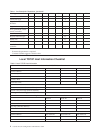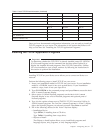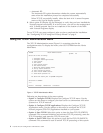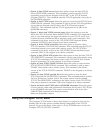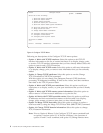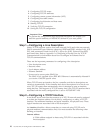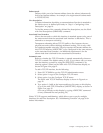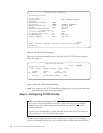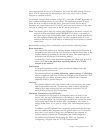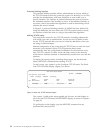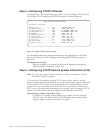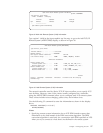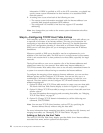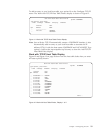
When you are finished adding entries, the Work with TCP/IP Interfaces display
looks like Figure 4.
Note: Any change to the TCP/IP interfaces configuration, except for the automatic
start parameter, takes effect immediately.
Step 3—Configuring TCP/IP Routes
Do you need to add routes at all?
If you have several individual networks to which the server is not directly
attached, you must add routing entries to allow the server to reach these
remote networks.
If your server is attached to a single network and if there are no IP routers in
your network, you do not need to add routes.
To reach remote networks, at least one routing entry is required. If no routing
entries are manually added, your server cannot reach systems that are not on the
Add TCP/IP Interface (ADDTCPIFC)
Type choices, press Enter.
Internet address........
Line description........ Name, *LOOPBACK, *VIRTUALIP
Subnet mask ..........
Associated local interface... *NONE
Type of service ........ *NORMAL *MINDELAY, *MAXTHRPUT...
Maximum transmission unit . . . *LIND 576-16388, *LIND
Autostart ........... *YES *YES, *NO
PVC logical channel identifier 001-FFF
+ for more values
X.25 idle circuit timeout . . . 60 1-600
X.25 maximum virtual circuits . 64 0-64
X.25 DDN interface....... *NO *YES, *NO
TRLAN bit sequencing...... *MSB *MSB, *LSB
Bottom
F3=Exit F4=Prompt F5=Refresh F12=Cancel F13=How to use this display
F24=More key
Figure 3. Add TCP/IP Interfaces Display
Work with TCP/IP Interfaces
System: SYSNAM890
Type options, press Enter.
1=Add 2=Change 4=Remove 5=Display 9=Start 10=End
Internet Subnet Line Line
Opt Address Mask Description Type
- 9.4.73.129 255.255.255.128 ETHLINE *ELAN
Figure 4. Work with TCP/IP Interfaces Display
12 OS/400 TCP/IP Configuration and Reference V5R1



